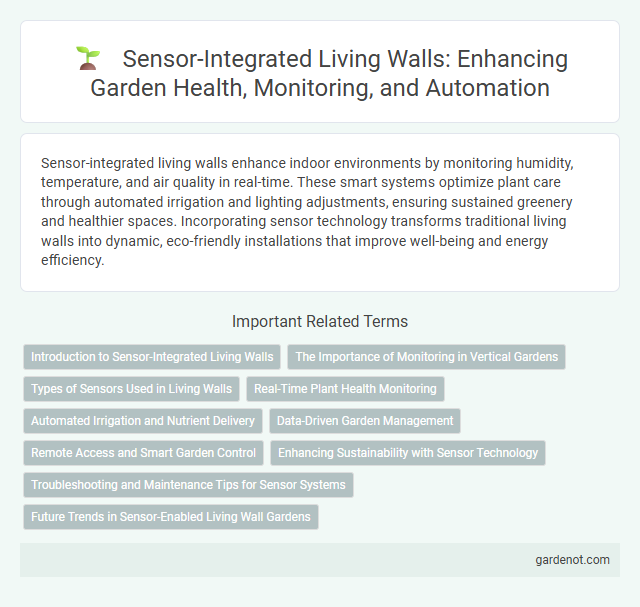Sensor-integrated living walls enhance indoor environments by monitoring humidity, temperature, and air quality in real-time. These smart systems optimize plant care through automated irrigation and lighting adjustments, ensuring sustained greenery and healthier spaces. Incorporating sensor technology transforms traditional living walls into dynamic, eco-friendly installations that improve well-being and energy efficiency.
Introduction to Sensor-Integrated Living Walls
Sensor-integrated living walls combine advanced environmental sensors with vertical gardens to monitor and optimize plant health, humidity, and air quality in real time. These systems use data from moisture, temperature, and light sensors to automate irrigation and adjust environmental conditions for optimal plant growth. Integrating IoT technology enhances the sustainability and efficiency of living walls, making them dynamic biofilters and aesthetic elements in smart buildings.
The Importance of Monitoring in Vertical Gardens
Sensor-integrated walls play a crucial role in monitoring vertical gardens by tracking moisture levels, temperature, and light exposure to optimize plant health and growth. Real-time data from these sensors ensures efficient irrigation and nutrient delivery, preventing overwatering and disease. Continuous monitoring enhances sustainability and longevity of living walls, making them more resilient and vibrant in urban environments.
Types of Sensors Used in Living Walls
Sensor-integrated living walls commonly utilize moisture sensors to monitor soil hydration levels, ensuring optimal water delivery for plant health. Light sensors measure ambient light intensity, allowing the system to adjust artificial lighting or shading to support photosynthesis. Temperature and humidity sensors track microclimate conditions within the wall, enabling precise environmental control to maintain plant vitality and prevent disease.
Real-Time Plant Health Monitoring
Sensor-integrated living walls utilize advanced IoT technology to provide real-time plant health monitoring, ensuring optimal growth conditions through accurate data on soil moisture, temperature, and light levels. These smart sensors detect early signs of plant stress or disease, enabling timely interventions to maintain vibrant greenery and prevent damage. Continuous data collection supports efficient water usage and nutrient management, enhancing sustainability and reducing maintenance costs.
Automated Irrigation and Nutrient Delivery
Sensor-integrated living walls utilize advanced moisture and nutrient sensors to precisely monitor plant health and soil conditions in real time. Automated irrigation systems activate only when sensors detect inadequate moisture levels, minimizing water waste and promoting optimal plant growth. Nutrient delivery is similarly regulated through embedded sensors that analyze soil nutrient content, ensuring plants receive balanced feeding tailored to their specific needs.
Data-Driven Garden Management
Sensor-integrated living walls utilize real-time data on humidity, temperature, and light levels to optimize plant health and resource efficiency. These smart systems enable precise irrigation schedules and nutrient delivery, reducing water waste and enhancing growth performance. Continuous monitoring supports proactive maintenance, promoting sustainable and vibrant vertical gardens.
Remote Access and Smart Garden Control
Sensor-integrated living walls featuring remote access technology enable real-time monitoring of soil moisture, light levels, and temperature to optimize plant health. Smart garden control systems allow users to adjust irrigation schedules and lighting remotely via mobile apps, reducing water waste and enhancing growth efficiency. These innovations empower urban gardeners to maintain lush, sustainable vertical gardens with minimal effort and precise environmental management.
Enhancing Sustainability with Sensor Technology
Sensor-integrated living walls use advanced environmental sensors to monitor moisture levels, light exposure, and air quality in real time, optimizing plant health and reducing water waste. These intelligent systems enable automated irrigation and nutrient delivery tailored to specific plant needs, significantly lowering resource consumption. By integrating sensor technology, living walls contribute to sustainable building design through improved energy efficiency and enhanced indoor air purification.
Troubleshooting and Maintenance Tips for Sensor Systems
Sensor-integrated living walls require regular calibration and cleaning of moisture, light, and temperature sensors to maintain optimal plant health and system accuracy. Common troubleshooting steps include checking for sensor connectivity issues, recalibrating sensors after power interruptions, and ensuring firmware updates are applied. Preventive maintenance, such as inspecting wiring for corrosion and clearing debris from sensor surfaces, extends system lifespan and improves data reliability.
Future Trends in Sensor-Enabled Living Wall Gardens
Sensor-integrated living wall gardens are transforming urban greening by enabling real-time monitoring of moisture, light, and nutrient levels to optimize plant health and resource efficiency. Advances in IoT and AI technologies allow these walls to autonomously adjust irrigation and lighting systems, reducing water consumption by up to 30% while promoting sustainable urban ecosystems. Future trends emphasize enhanced data analytics and integration with smart building management systems to create adaptive environments that improve air quality and occupant well-being.
Sensor-integrated wall Infographic

 gardenot.com
gardenot.com